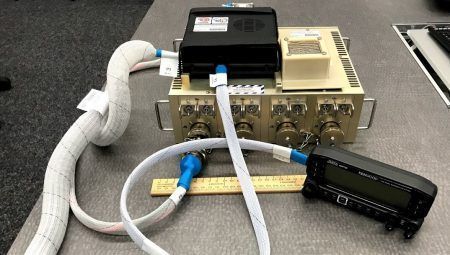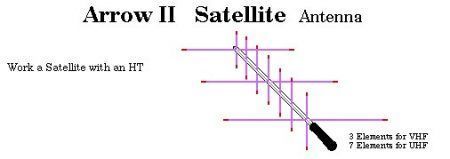I’ve been threatening to get on the satellites for years now. It’s just been one of those things that never percolated up to the top of my list. I finally bit the bullet, though, and actually made my first satellite contact Tuesday!
Several things finally motivated me to do this. One, I’ve been feeling like I’ve been in a rut. Not just with ham radio, but with life in general. I’m sure that I’m not the only one feeling this way. I felt like I needed to do something different to shake things up a bit.
Two, among my followers, and those who I follow on Twitter, there are many satellite operators, including KI4ASK, KM4LAO, 2M0SQL, KX9X, and many others. Hearing about their exploits certainly gave me a push in the right direction.
Third, was the news about the International Space Station’s new crossband repeater. It sounded pretty cool to me to be able to bounce a signal off the ISS. After reading this news, I programmed my HT to the receive frequency, 437.800 MHz, and wouldn’t you know it, the ISS was passing nearly overhead at that exact time, and I copied a few callsigns on just the HT antenna. I took that as an omen.
Next, I had to decide on what kind of antenna to buy or build. I initially considered building my own antenna. There are lots of web pages and YouTube videos that show you how to build a satellite antenna. One of the many that caught my eye was Satellite Log Periodic Antenna Project Pt. 1.
In the end, though, I decided that if I tried building one I might get bogged down in the construction process instead of making contacts. I did some research on commercial antennas, and the choice seemed to be an antenna from Arrow Antennas and the Elk Antennas. Both Martin, M1MRB and Edmund, M0MNG, my co-hosts on the ICQPodcast, have Elk antennas, but when I asked on Twitter, the nearly unanimous choice was the Arrow antenna. Jeff, KE9V, settled that dispute when he noted that if I bought an Arrow antenna through AMSAT, that AMSAT would make a few bucks from the sale. So, I got the Arrow. I re-joined AMSAT, too.
It took me a few days to put the antenna together, and then discovered that I didn’t have the right adapters to connect it to the radio. After consulting with the Twitter gods, I purchased some from Amazon (BNC-SMA, BNC-reverse SMA). In the meantime, I programmed my radio for the new ISS cross-band repeater. For help in doing so, I found this great blog post. I thought that this might be the most logical one to try first, but I didn’t take into account how busy it would be. Since it’s the newest satellite station on the air, everyone wants to work it.
Next, I had to figure out when when the ISS was going to be overhead. I went back to the Twitter gods for recommendations for a satellite-tracking program, and among them was N2YO.Com. I like N2YO.Com. Using it, I was able to determine that the ISS would be passing nearly over head a little after 0030Z that evening.
I thought that tracking the ISS was going to be easy. At 0000Z, the sky was clear, and on a 2m net, I was assured by a local ham, who happens to be a professor emeritus of astronomy at the University of Michigan, that the ISS would be the brightest object in the sky. Unfortunately, by 0030Z, the sky had clouded over, and I never actually saw the satellite. I didn’t make a contact, either. I did hear the ISS repeater, but no one heard me.
After that, I refined my approach. I expanded the number of satellites I now have programmed into my radio and upped the transmit power to 5W. The satellites that I have now programmed into my radio include:
- ISS
- DIWATA-2B (PO-101)
- FOX-1B
- FOX-1CLIFF
- SAUDISAT-1C (SO-50)
- FOX-1D
My strategy finally paid off. Just before lunch last Tuesday, I stood on my back porch and had a QSO with ND0C via PO-101! That was quite exciting. I can see where this might get addicting.
This has been a real learning experience, and isn’t that what ham radio is all about? I’ve been thinking about a number of ways to learn more and enhance my satellite operating experience:
- Build a satellite antenna. Like I said earlier, I’m a big believer in building, rather than buy antennas, and, if I build a log-periodic, I can compare the performance of the log periodic to the Arrow Yagi antenna.
- Build a SatNOGS ground station. I’ve always thought that this project was very cool. The SatNOGS website is a wealth of information on how to do this.
- Move to higher ground. I’m kind of in a hollow here, so I don’t hear the satellites until they get fairly high in the sky, and eventhen, the pass is fairly short, unless they are going right overhead. There’s a park up at the top of the hill, which is just about the highest point in Ann Arbor, and I think trying from there will give me clear shot at many satellites.
- Try the linear satellites. One bit of advice I got from Twitter is to try the linear satellites instead of the FM satellites. They’re less busy than the FM satellites, and you can work them with SSB and CW. I think that would be pretty cool. I may be wrong, but it looks to me like the IC-705 would be the perfect radio to do this. I think that if I sell my KX-3 and some other stuff I’m really not using, I could afford to buy one.
One thing’s for sure. This has gotten me out of my ham radio rut. And, in times like these, that’s a good thing.


No comments:
Post a Comment